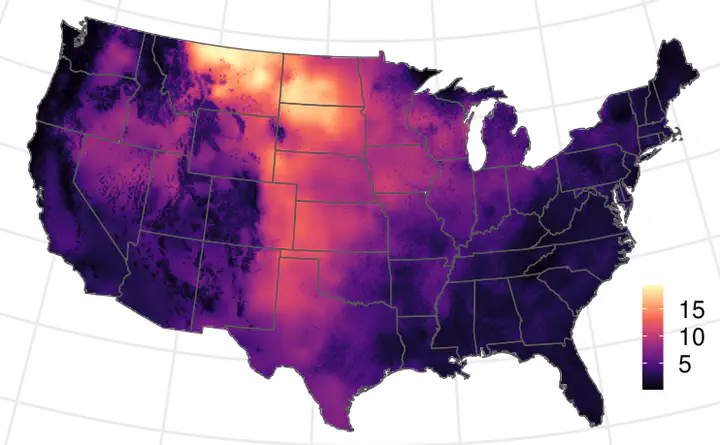Developing statistical models to understand ecological processes across macroscales

Understanding the drivers of species distributions, forest resources, and biodiversity at macroscales is complicated by a variety of ecological and observational complexities, such as spatial autocorrelation, nonstationarity in species-environment relationships, and species interactions. In the Statistical Ecology and Forest Science Lab, we account for these complexities to provide a more complete understanding of macroscale ecological processes and inform effective monitoring and conservation approaches across spatial scales.
Previous and ongoing work in the lab has focused on both model development and applications of such models to inform management and conservation objectives for birds, forests, butterflies, anurans, and bats. With collaborators at the National Park Service, we built a community abundance model that accounted for imperfect detection to understand forest bird abundance trends of >100 species across a network of protected forests in the Northeastern US (Doser et al. 2021 Ecological Applications), which revealed abundance trends were heterogeneous across space but consistent among species within a protected area. Recognizing the increased proliferation of publicly available data sources, we developed an integrated community occupancy model that fuses multiple detection-nondetection data sources within a single statistical model to improve our ability to estimate species and biodiversity dynamics (Doser et al. 2022 Methods in Ecology and Evolution).
Modeling across macroscales increasingly requires spatially-explicit approaches that can leverage the spatial distribution of data points to improve model predictive performance. We developed a joint species distribution model that accounts for spatial autocorrelation, imperfect detection, and species correlations to yield more accurate estimates of species distributions and biodiversity (Doser, Finley, Banerjee 2023 Ecology). We have also developed new methodological approaches to estimate spatially-varying (or nonstationary) species-environment relationships (Doser et al. 2024 JABES), as well as practical guidelines and recommendations for the use of these models in ecology and conservation (Doser et al. 2024 GEB). In collaboration with the Minnesota Department of Natural Resources, we are extending this framework to estimate spatially-varying, nonlinear trends in a community of anurans across Minnesota, showcasing the potential of spatially-varying trend models to inform coordinated, multi-scale management action plans.
We are currently working on a variety of projects in which we are leveraging spatially-explicit modeling approaches to understand ecological processes across macroscales. With collaborators across Europe and Michigan State University, we are leveraging a multi-species spatially-explicit abundance framework to quantify trends in Middle Eastern butterfly communities over the last 15 years. With collaborators at MSU, the National Audubon Society, and the National Park Service, we are estimating the relative importance of climate and land-use change in driving occupancy trends on over 300 bird species across the continental US over the last 20 years, which will provide important insights on where and what kinds of conservation actions will have the most impact on bird communities. With collaborators at the US Forest Service and University of Massachusetts Amherst, we are quantifying the effects of vapor pressure deficit and growing season precipitation on species-specific forest biomass across the western US.